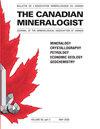从Lawsonite到Orientite的多体系列中缺失的一环
IF 1.5
4区 地球科学
Q3 MINERALOGY
引用次数: 1
摘要
demagstrisite (BaCa2Mn3+4(Si3O10)(Si2O7)(OH)4·3H2O)是在Cerchiara矿(意大利拉斯佩齐亚省利古里亚东部)发现的一种新矿物。矿石由含黄铁矿(5 ~ 15cm厚)的变质岩与富赤铁矿的燧石有韵律地夹层组成。辉石与绢云母(Mn)、绢云母、新辉长石、方解石、隐黑石、正长石、石英组成的基质中伴生有绢云母、辉长石、瑞子石和皂石。海辉石晶体呈紧密交织的叶片或毫米大小的棱柱状和针状,具有方形横截面,通常具有不规则的终止,很少以低角度的金字塔终止。该矿物为橙棕色至红棕色,条纹为米黄色,光泽为玻璃状,半透明至透明。骨折不规则。在薄片上,它是橙黄色的。该矿物呈双轴(-)光,α 1.805(5), β 1.825(5), γ 1.8305(5)(白光);2vme58(5)°,2Vcalc 54.7°;光学取向X = c, Y = b, Z = a.色散非常强,r > .多色性强,X为橙黄色,Y为红棕色,Z为红棕色;X 2σI)是基于沿[010]延伸的以Mn3+为中心的八面体的直边共享链,由二硅酸(Si2O7)和三硅酸(Si3O10)基团桥接,形成框架。这个框架内的空腔包含两个大的阳离子位点。其结构可以认为是介于东方石和新辉长岩结构之间的过渡性结构。demagstrisite是为了纪念Leandro de Magistris(1906-1990)而命名的。本文章由计算机程序翻译,如有差异,请以英文原文为准。
Demagistrisite, the Missing Link in a Polysomatic Series from Lawsonite to Orientite
Demagistrisite, ideally BaCa2Mn3+4(Si3O10)(Si2O7)(OH)4·3H2O, is a new mineral found at the Cerchiara mine (eastern Liguria, La Spezia province, Italy). The ore consists of rhythmic interlaying of braunite-bearing metasediments (5–15 cm thick) and hematite-rich cherts. Demagistrisite occurs in association with cerchiaraite-(Mn), namansilite, noelbensonite, orientite, richterite, ruizite, and saponite in matrix consisting of braunite, calcite, cryptomelane, orthoclase, and quartz. Demagistrisite crystals occur as tightly intergrown blades or as millimeter-sized prisms and needles with square cross-section, typically with irregular terminations, and rarely terminated by a low-angle pyramid. The mineral is orange brown to red brown, streak is beige, and luster is vitreous, translucent to transparent. Fracture is irregular. In thin section, it is orange brown. The mineral is optically biaxial (–) with α 1.805(5), β 1.825(5), γ 1.8305(5) (white light); 2Vmeas 58(5)°, 2Vcalc 54.7°; optical orientation X = c, Y = b, Z = a. Dispersion is very strong, r > v. Pleochroism is strong with X orange yellow, Y red brown, Z red brown; X << Z < Y. It is unreactive in concentrated HCl at room temperature. Thirteen chemical analyses by WDS-EMPA gave the following empirical formula (based on 24 O apfu): (Ba0.69Ca1.25Mn2+0.70Sr0.21Na0.12Mg0.02)Σ2.99(Mn3+3.97Al0.03)Σ4(Si3O10)(Si2O7)(OH)3.87·3.13H2O. The mineral is orthorhombic, space group Amm2, with unit-cell parameters a 16.312(8), b 6.176(4), c 9.075(6) Å, V 914.2(10) Å3, and Z = 2. The seven strongest X-ray powder diffraction lines are [d Å (I%; hkl)]: 16.21 (49; 100), 4.86 (44; 111), 4.34 (56; 102,211), 2.871 (54; 220), 2.731 (100; 511,013), 2.671 (74; 320,113,502), and 2.426 (51; 222,313,611). The crystal structure (R1 = 0.0572 for 1485 reflections with I > 2σI) is based on straight edge-sharing chains of Mn3+-centered octahedra extending along [010], which are bridged by disilicate (Si2O7) and trisilicate (Si3O10) groups, yielding a framework. Cavities within this framework contain two large cation sites. The structure of demagistrisite can be considered transitional between the structures of orientite and noelbensonite. Demagistrisite is named in honor of Leandro de Magistris (1906–1990).
求助全文
通过发布文献求助,成功后即可免费获取论文全文。
去求助
来源期刊

Canadian Mineralogist
地学-矿物学
CiteScore
2.20
自引率
22.20%
发文量
45
审稿时长
4-8 weeks
期刊介绍:
Since 1962, The Canadian Mineralogist has published papers dealing with all aspects of mineralogy, crystallography, petrology, economic geology, geochemistry, and applied mineralogy.
 求助内容:
求助内容: 应助结果提醒方式:
应助结果提醒方式:


